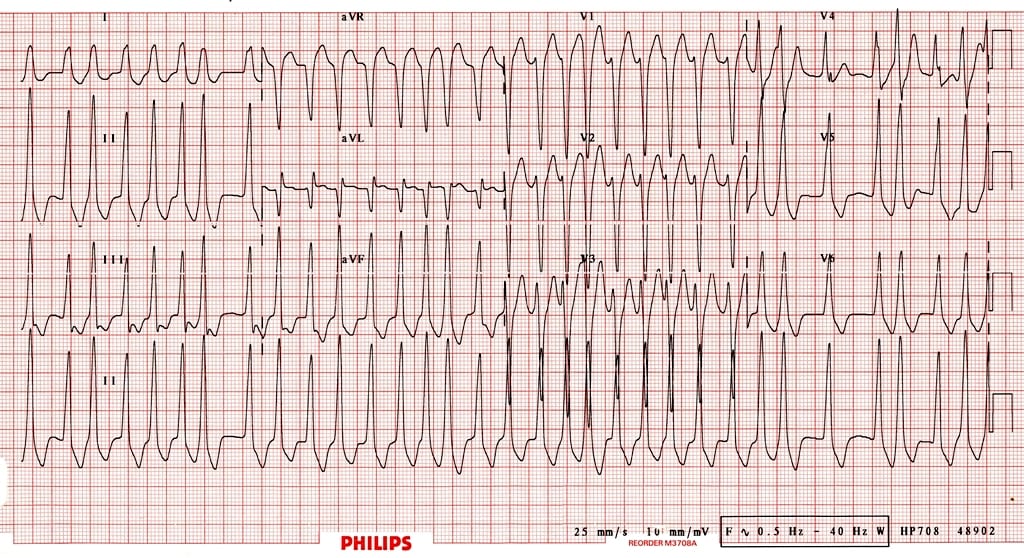Tachycardias in Wolff-Parkinson-White Syndrome
Reentry Tachycardia
Tachycardias in WPW syndrome are produced by a macro-reentry circuit via the accessory pathway and the AV node. Of WPW patients with reentry tachycardia, 90% have orthodromic reentry tachycardia, which is caused by retrograde impulse conduction in the accessory pathway and conduction in the antegrade direction along the AV node.
In orthodromic reentry tachycardia, the QRS complex is normal if there is no additional bundle-branch block present. The delta wave can go undetected. The ECG pattern resembles AV nodal reentry tachycardia, and only electrophysiologic studies can delineate between the two. A negative P wave is seen on precordial lead V1. The R-R interval is shortened, and the RP interval is longer than the PR interval.
The second type of reentry tachycardia in WPW syndrome occurs in 10% of cases. In these patients, impulse conduction through the accessory pathway is in the anterograde direction, while there is retrograde conduction of impulses along the AV node. This is known as antidromic reentry tachycardia. The QRS complex resembles the typical WPW pattern with a delta wave.
Both types of reentry tachycardia have a regular rhythm with a ventricular beat of 140–300 bpm. When the rate reaches 220 bpm, negative P waves are sometimes observed in the inferior frontal leads III and aVF. This is caused by retrograde activation of the atria.
Atrial Fibrillation in Wolff-Parkinson-White Syndrome
Atrial fibrillation occurs in 10–30% of patients diagnosed with WPW syndrome. Atrial fibrillation impulses are generated within the atria or pulmonary veins, independent of the accessory pathway. However, the accessory pathway functions as an alternate route for the conduction of impulses from the atrium to the ventricle. It has been suggested that the atrioventricular accessory pathway may trigger atrial fibrillation due to retrograde impulse conduction to the atrium at the same time that it is susceptible to the production of atrial fibrillation.
These patients have ECG findings of both atrial fibrillation and an accessory pathway. The rhythm is irregularly irregular, and the QRS complexes change with every beat. These findings are attributed to the rapid transmission of impulses between the atria and ventricles. There will be a sustained ventricular beat of 180–200 bpm. If the atrial impulses are transmitted along the accessory pathway in atrial fibrillation, the ventricular rate can reach 300 bpm, which can progress to ventricular fibrillation.
QRS morphology and the rate of impulse conduction in atrial fibrillation along the accessory pathway are influenced by the length of the accessory pathway refractory period, the length of the antegrade impulse conduction, and the magnitude of the preexcitation. It is also influenced by the degree of competition between the AV node/His-Purkinje system and the accessory pathway for ventricular activation, the presence of multiple accessory pathways, and the degree of retrograde activation of the accessory pathway.
The QRS complexes get wider as preexcitation increases. Patients with short refractory periods and rapid atrial fibrillation are at risk for developing ventricular fibrillation.

Atrial Fibrillation in WPW Syndrome ECG 45
The ECG in figure 5 represents atrial fibrillation in the presence of WPW syndrome. There is a rapid, irregular, and broad QRS complex tachycardia with an estimated heart rate of 200 bpm. LBBB morphology with a dominant S wave is seen in V1. This may be misinterpreted as atrial fibrillation with concomitant LBBB. However, the ECG findings are not typical of LBBB because the rate is too fast to be conducted via the AV node, and there are beat-to-beat variations in the QRS complexes. These findings are more typical of WPW syndrome.
Atrial Flutter in Wolff-Parkinson-White Syndrome
Atrial flutter is caused by a reentrant circuit in the right atrium that is not dependent on the AV node. It is independent of the accessory pathway. Atrial flutter can conduct impulses in the antegrade direction through the accessory pathway, which produces preexcitation tachycardia.
Atrial flutter can conduct at a 1:1 ratio when there is preexcitation tachycardia. This may be erroneously interpreted as ventricular tachycardia. If the atrial flutter transmits impulses through the accessory pathway, ventricular rates can exceed 300 bpm, and the patient may progress into ventricular fibrillation.
45 Burns E. Pre-excitation syndromes. Life in the fastlane website. Accessed September 24, 2020.
https://litfl.com/wp-content/uploads/2018/08/ECG-WPW-Atrial-fibrillation-3.jpg